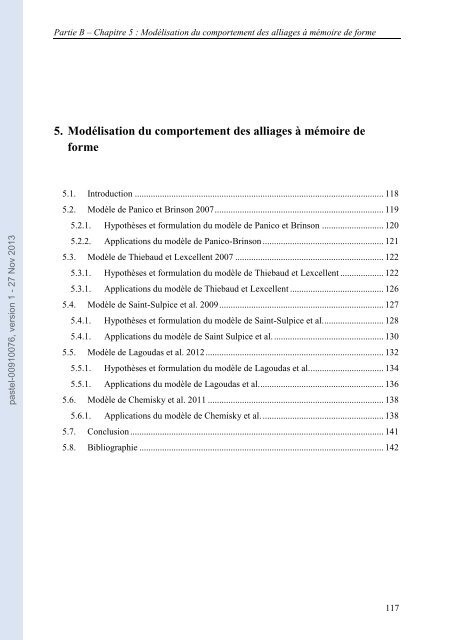Dialogue essais-simulation et identification de lois de comportement ...
Dialogue essais-simulation et identification de lois de comportement ...
Dialogue essais-simulation et identification de lois de comportement ...
You also want an ePaper? Increase the reach of your titles
YUMPU automatically turns print PDFs into web optimized ePapers that Google loves.
Partie B – Chapitre 5 : Modélisation du <strong>comportement</strong> <strong>de</strong>s alliages à mémoire <strong>de</strong> forme<br />
5. Modélisation du <strong>comportement</strong> <strong>de</strong>s alliages à mémoire <strong>de</strong><br />
forme<br />
pastel-00910076, version 1 - 27 Nov 2013<br />
5.1. Introduction ............................................................................................................. 118<br />
5.2. Modèle <strong>de</strong> Panico <strong>et</strong> Brinson 2007 .......................................................................... 119<br />
5.2.1. Hypothèses <strong>et</strong> formulation du modèle <strong>de</strong> Panico <strong>et</strong> Brinson ........................... 120<br />
5.2.2. Applications du modèle <strong>de</strong> Panico-Brinson ..................................................... 121<br />
5.3. Modèle <strong>de</strong> Thiebaud <strong>et</strong> Lexcellent 2007 ................................................................. 122<br />
5.3.1. Hypothèses <strong>et</strong> formulation du modèle <strong>de</strong> Thiebaud <strong>et</strong> Lexcellent ................... 122<br />
5.3.1. Applications du modèle <strong>de</strong> Thiebaud <strong>et</strong> Lexcellent ......................................... 126<br />
5.4. Modèle <strong>de</strong> Saint-Sulpice <strong>et</strong> al. 2009 ........................................................................ 127<br />
5.4.1. Hypothèses <strong>et</strong> formulation du modèle <strong>de</strong> Saint-Sulpice <strong>et</strong> al. .......................... 128<br />
5.4.1. Applications du modèle <strong>de</strong> Saint Sulpice <strong>et</strong> al. ................................................ 130<br />
5.5. Modèle <strong>de</strong> Lagoudas <strong>et</strong> al. 2012 .............................................................................. 132<br />
5.5.1. Hypothèses <strong>et</strong> formulation du modèle <strong>de</strong> Lagoudas <strong>et</strong> al. ................................ 134<br />
5.5.1. Applications du modèle <strong>de</strong> Lagoudas <strong>et</strong> al. ...................................................... 136<br />
5.6. Modèle <strong>de</strong> Chemisky <strong>et</strong> al. 2011 ............................................................................. 138<br />
5.6.1. Applications du modèle <strong>de</strong> Chemisky <strong>et</strong> al. ..................................................... 138<br />
5.7. Conclusion ............................................................................................................... 141<br />
5.8. Bibliographie ........................................................................................................... 142<br />
117
















